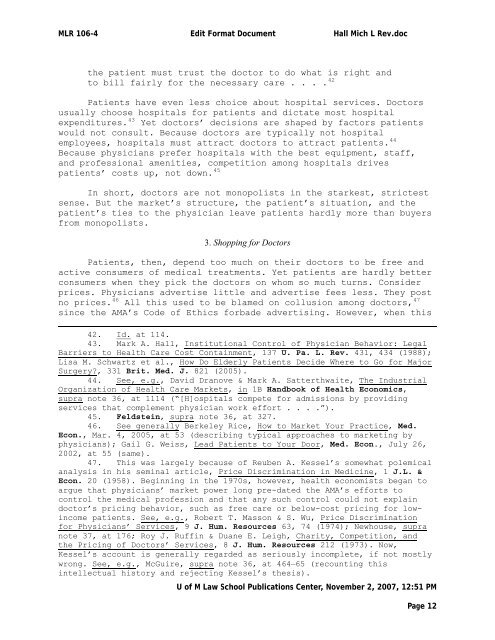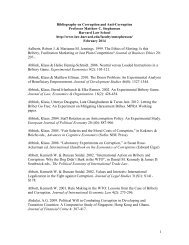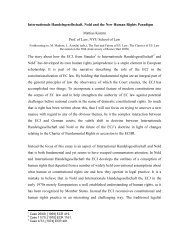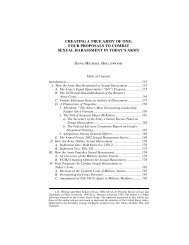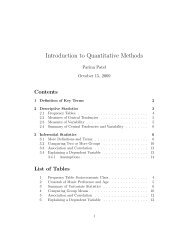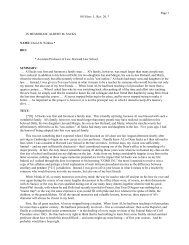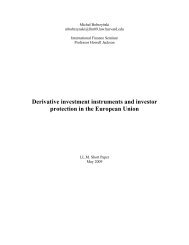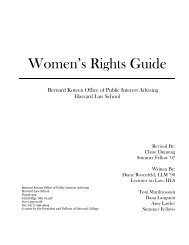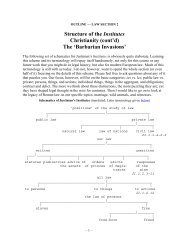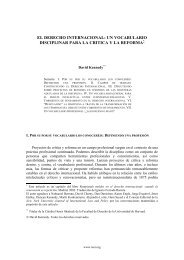Patients as Consumers - Harvard Law School
Patients as Consumers - Harvard Law School
Patients as Consumers - Harvard Law School
Create successful ePaper yourself
Turn your PDF publications into a flip-book with our unique Google optimized e-Paper software.
MLR 106-4 Edit Format Document Hall Mich L Rev.doc<br />
the patient must trust the doctor to do what is right and<br />
to bill fairly for the necessary care . . . . 42<br />
<strong>Patients</strong> have even less choice about hospital services. Doctors<br />
usually choose hospitals for patients and dictate most hospital<br />
expenditures. 43 Yet doctors’ decisions are shaped by factors patients<br />
would not consult. Because doctors are typically not hospital<br />
employees, hospitals must attract doctors to attract patients. 44<br />
Because physicians prefer hospitals with the best equipment, staff,<br />
and professional amenities, competition among hospitals drives<br />
patients’ costs up, not down. 45<br />
In short, doctors are not monopolists in the starkest, strictest<br />
sense. But the market’s structure, the patient’s situation, and the<br />
patient’s ties to the physician leave patients hardly more than buyers<br />
from monopolists.<br />
3. Shopping for Doctors<br />
<strong>Patients</strong>, then, depend too much on their doctors to be free and<br />
active consumers of medical treatments. Yet patients are hardly better<br />
consumers when they pick the doctors on whom so much turns. Consider<br />
prices. Physicians advertise little and advertise fees less. They post<br />
no prices. 46 All this used to be blamed on collusion among doctors, 47<br />
since the AMA’s Code of Ethics forbade advertising. However, when this<br />
42. Id. at 114.<br />
43. Mark A. Hall, Institutional Control of Physician Behavior: Legal<br />
Barriers to Health Care Cost Containment, 137 U. Pa. L. Rev. 431, 434 (1988);<br />
Lisa M. Schwartz et al., How Do Elderly <strong>Patients</strong> Decide Where to Go for Major<br />
Surgery?, 331 Brit. Med. J. 821 (2005).<br />
44. See, e.g., David Dranove & Mark A. Satterthwaite, The Industrial<br />
Organization of Health Care Markets, in 1B Handbook of Health Economics,<br />
supra note 36, at 1114 (“[H]ospitals compete for admissions by providing<br />
services that complement physician work effort . . . .”).<br />
45. Feldstein, supra note 36, at 327.<br />
46. See generally Berkeley Rice, How to Market Your Practice, Med.<br />
Econ., Mar. 4, 2005, at 53 (describing typical approaches to marketing by<br />
physicians); Gail G. Weiss, Lead <strong>Patients</strong> to Your Door, Med. Econ., July 26,<br />
2002, at 55 (same).<br />
47. This w<strong>as</strong> largely because of Reuben A. Kessel’s somewhat polemical<br />
analysis in his seminal article, Price Discrimination in Medicine, 1 J.L. &<br />
Econ. 20 (1958). Beginning in the 1970s, however, health economists began to<br />
argue that physicians’ market power long pre-dated the AMA’s efforts to<br />
control the medical profession and that any such control could not explain<br />
doctor’s pricing behavior, such <strong>as</strong> free care or below-cost pricing for lowincome<br />
patients. See, e.g., Robert T. M<strong>as</strong>son & S. Wu, Price Discrimination<br />
for Physicians’ Services, 9 J. Hum. Resources 63, 74 (1974); Newhouse, supra<br />
note 37, at 176; Roy J. Ruffin & Duane E. Leigh, Charity, Competition, and<br />
the Pricing of Doctors’ Services, 8 J. Hum. Resources 212 (1973). Now,<br />
Kessel’s account is generally regarded <strong>as</strong> seriously incomplete, if not mostly<br />
wrong. See, e.g., McGuire, supra note 36, at 464–65 (recounting this<br />
intellectual history and rejecting Kessel’s thesis).<br />
U of M <strong>Law</strong> <strong>School</strong> Publications Center, November 2, 2007, 12:51 PM<br />
Page 12


